To view a webinar discussion on key findings with PRRI’s CEO Melissa Deckman, Heath Brown, and PRRI Public Fellows Kelsy Burke, Andrew R. Flores, and Suzanna Krivulskaya, click here.
Overview of the Study
Political debates about gender identity have become heated in recent years, as some state legislatures have increasingly sought to restrict transgender rights. Battles over how — or even if — sexual orientation and gender identity should be discussed in public schools are also erupting at school boards nationally, amid larger frustrations with public education that have emerged in the wake of the pandemic and other social tumult.
This new study of more than 5,000 Americans takes a closer look at Americans’ views on gender identity and what is appropriate to teach in public schools with respect to sexual orientation and gender identity. We also gauge Americans’ comfort levels with the idea of a friend using gender-neutral pronouns or pronouns that may not match the respondent’s perception of their friend’s gender. We also ask Americans their thoughts about the age at which children should receive sex education in public schools and what content is appropriate. We consider how partisanship, religion, media trust, parental status, and generation relate to people’s views on these matters. We also consider how knowing people who are LGBTQ influences such views.
Is Gender Binary?
In the past several years, views have shifted on gender identities. In 2021, nearly six in ten Americans (59%) said there are only two gender identities, man and woman, and 40% of Americans believed there are many gender identities. The following year, in 2022, 62% of Americans believed that there are only two gender identities, and more than one-third (35%) said there are many gender identities. This divide slightly increased again in 2023, with 65% saying there are two gender identities and 34% saying there are many.
Partisanship and Religious Tradition
The discourse on the gender binary is highly polarized along partisan lines. Around nine in ten Republicans believe there are only two genders (87% in 2021, 90% in 2023). Democrats, by contrast, are less likely to believe that there are only two genders (38% in 2021, 44% in 2023). Independents have become more likely in the past few years to say that there are only two genders (60% in 2021, 66% in 2023).
Beliefs in a gender binary increased or remained steady from 2021 to 2023 among all religious groups. In 2021, 86% of white evangelical Protestants said there are only two genders, compared with 92% in 2023. In both years, around eight in ten Hispanic Protestants and Latter-day Saints said there are only two genders (79% and 82%, respectively, in 2021, and 81% and 81% in 2023). More than seven in ten Black Protestants (73% in 2021 and 71% in 2023) and around two-thirds of white mainline/non-evangelical Protestants (65% in 2021 and 67% in 2023) say there are only two genders. White Catholics have gone from more than six in ten in 2021 (62%) to nearly seven in ten in 2023 (69%) believing there are only two genders. Other Protestants of color and Hispanic Catholics have had the most drastic changes on this question among the religious groups. In 2021, 52% of other Protestants of color believed there are only two genders, compared with 73% in 2023. Hispanic Catholics went from 48% to 66%.
Like Hispanic Catholics, followers of other non-christian religions went from a minority saying there are only two genders in 2021 (42%) to the majority having that belief in 2023 (55%). Jewish Americans have remained consistent, at 44%, on this question. Religiously unaffiliated Americans who believe in only two genders have increased but remain in the minority, going from 38% in 2021 to 46% in 2023.[1]
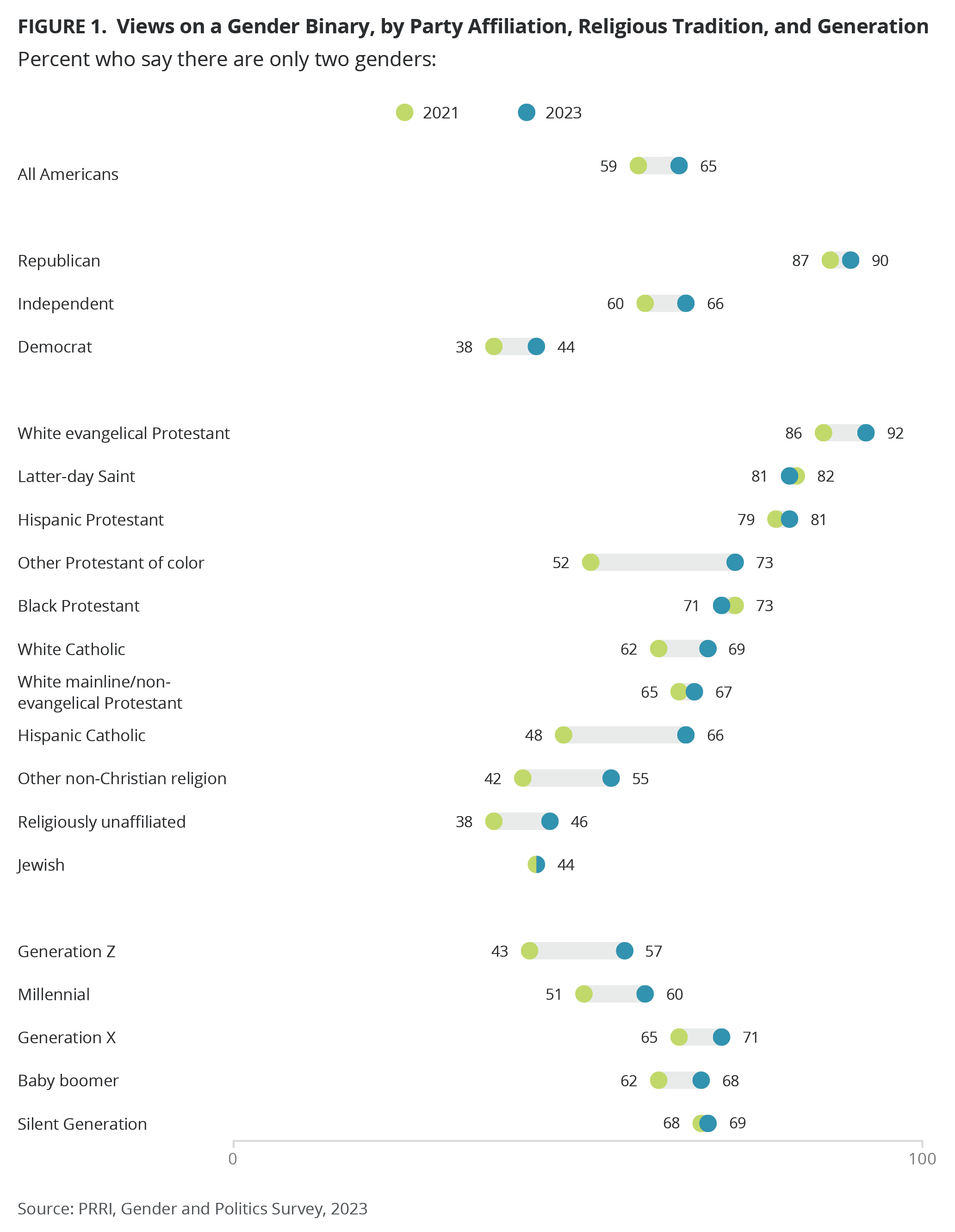
Generational Views
Younger generations are significantly less likely to believe that there are only two genders, but belief in a gender binary has increased among both Generation Z and millennials over the past several years.[2] In 2021, Generation Z (43%) and millennials (51%) were more closely aligned with each other on this question than they were with Generation X (65%), baby boomers (62%), and the Silent Generation (68%).
In 2023, Generation Z saw a jump in the belief that there are only two genders (rising to 57%, from 43% in 2021). In 2023, members of Generation Z (57%) and millennials (60%) still hold closer beliefs to each other on this question than they do to Generation X (71%), baby boomers (68%), and the Silent Generation (69%).
There is a significant gender difference in views on the gender binary in every generation except for millennials, with men being more likely than women to believe there is a gender binary (64% of men vs. 50% of women in Generation Z, 61% vs. 59% among millennials, 75% vs. 67% among Generation X, 73% vs. 65% among baby boomers, and 76% vs. 62% among the Silent Generation).
Media Trust
Views of gender vary widely depending on the news sources people trust. The vast majority of Americans who trust either Fox News or conservative news sources believe there are only two genders (82% and 96%, respectively, in 2021, and 91% and 92% in 2023). Six in ten Americans who do not trust any TV news sources said they think there are only two genders in 2021 (60%) and almost two-thirds say the same in 2023 (65%). Those Americans who trust mainstream news sources are less likely than the other groups to say that there are only two genders (51% in 2021, and 56% in 2023).
Demographics
There is little difference between racial groups on views regarding binary gender. However, as with the trends discussed above, belief in the idea of a gender binary increased in most racial groups from 2021 to 2023. In 2021, 56% of both Hispanic Americans and multiracial Americans said they believed there are only two genders. In 2023, however, 66% of Hispanic Americans agree that there is a gender binary, and the number has dipped slightly among multiracial Americans, to 54%. Among white Americans, belief in a gender binary went from 60% in 2021 to 66% in 2023. Similarly, the share of Black Americans who agree with this view went from 65% to 70%. For AAPI Americans, we only have numbers for 2023, but they are less likely than all other racial groups to believe there are only two genders, with just more than half believing this idea (53%).
In 2021, more than six in ten Americans with only a high school education or less (62%) and Americans with some college education (64%) believed that there are only two genders, compared with 54% of Americans with a college degree and 45% of Americans with a postgraduate degree. In 2023, however, 73% of Americans with only a high school education or less say there are only two genders while 67% of Americans with some college education believe the same. Similarly, the majority of Americans with a college degree (58%) or a postgraduate degree (53%) agree that gender is binary. White Americans with no college education are more likely than white Americans with a college degree to believe there are only two genders (64% vs. 51% in 2021, and 72% vs. 54% in 2023).
Parents and nonparents hold similar views on gender.[3] In 2021, 59% of both parents and nonparents believed in binary gender. In 2023, numbers increased for both groups, but parents (70%) were more likely than nonparents (64%) to agree that there is a gender binary.
In 2023, belief in a gender binary is much lower among Americans who either identify as gay, lesbian, or bisexual, or have a family member or close friend who does (56%), compared with Americans who only have an acquaintance who is gay, lesbian, or bisexual (73%) or who don’t know anyone who is (79%). Agreement with this idea is around four in ten for Americans who either identify as transgender or have a family member or close friend who does (40%) and for those gender-neutral pronouns (42%). Meanwhile, half or slightly more of those who have an acquaintance is transgender (53%) or who uses gender-neutral pronouns (50%) believe in a gender binary, as do three in four Americans who don’t know anyone who is transgender (75%) or who uses gender-neutral pronouns (76%).
Strong Salience for a Gender Binary in 2023
Turning to the 2023 survey, half of Americans (50%) say they feel strongly that there are only two genders, man and woman. Partisanship, religious tradition, education, and media trust are correlated with significant differences in the salience of belief in a gender binary.
Eight in ten Republicans (80%) say they feel strongly that there are only two genders, which is significantly higher than the share of independents (48%) and Democrats (28%) who hold the same view.
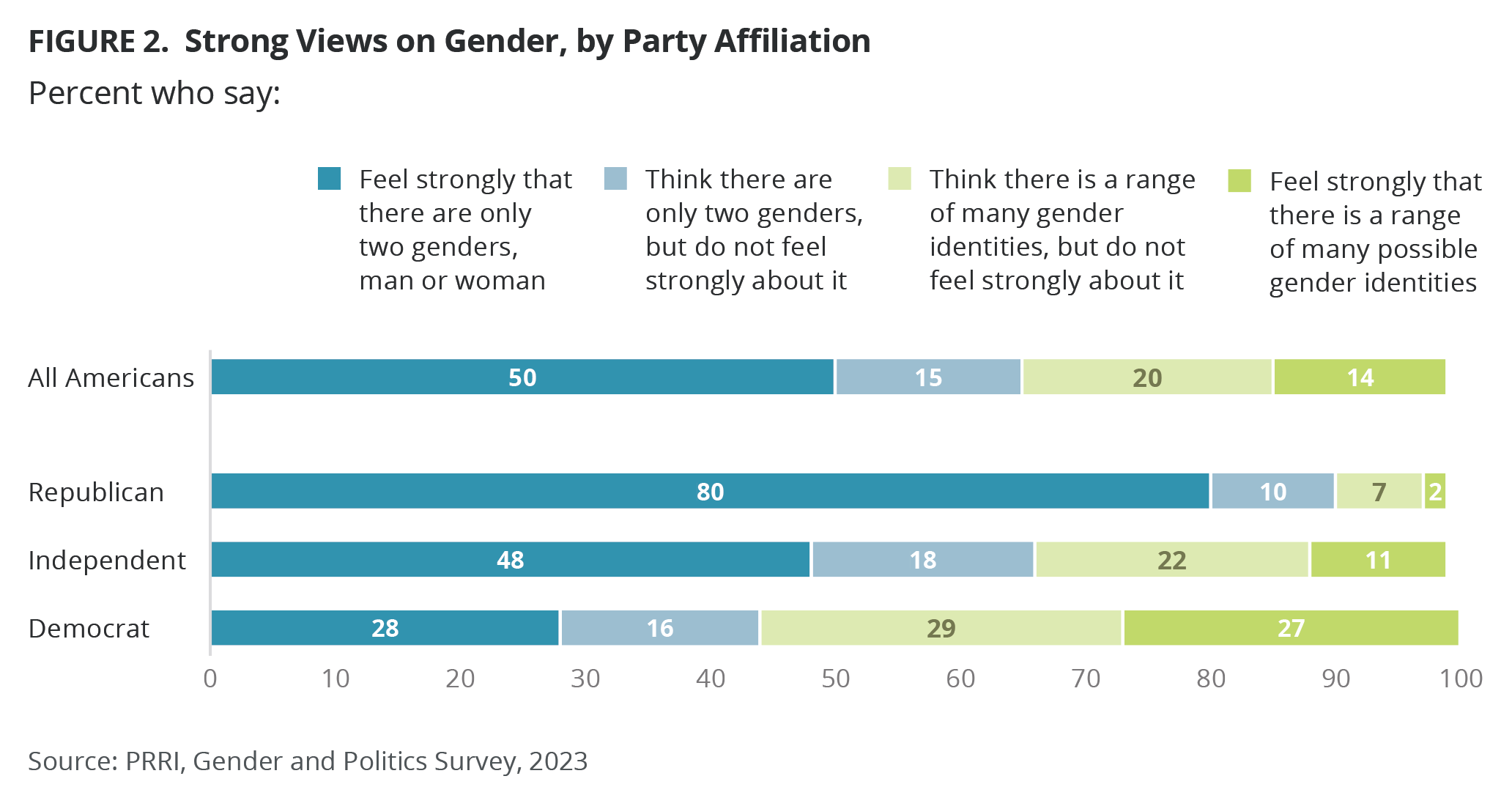
Among white Christian groups, white evangelical Protestants (82%) and Latter-day saints (72%) are much more likely than white Catholics (51%) and white mainline/non-evangelical Protestants (50%) to strongly feel there are only two genders. Hispanic Protestants (70%) are more likely to express strong belief in a gender binary than are other Christian groups of color (58% of Black Protestants, 55% of other Protestants of color, and 52% of Hispanic Catholics). Around four in ten Americans who belong to other non-Christian religions (42%) and three in ten Jewish (32%) and religiously unaffiliated Americans (30%) strongly feel that there are only two genders.
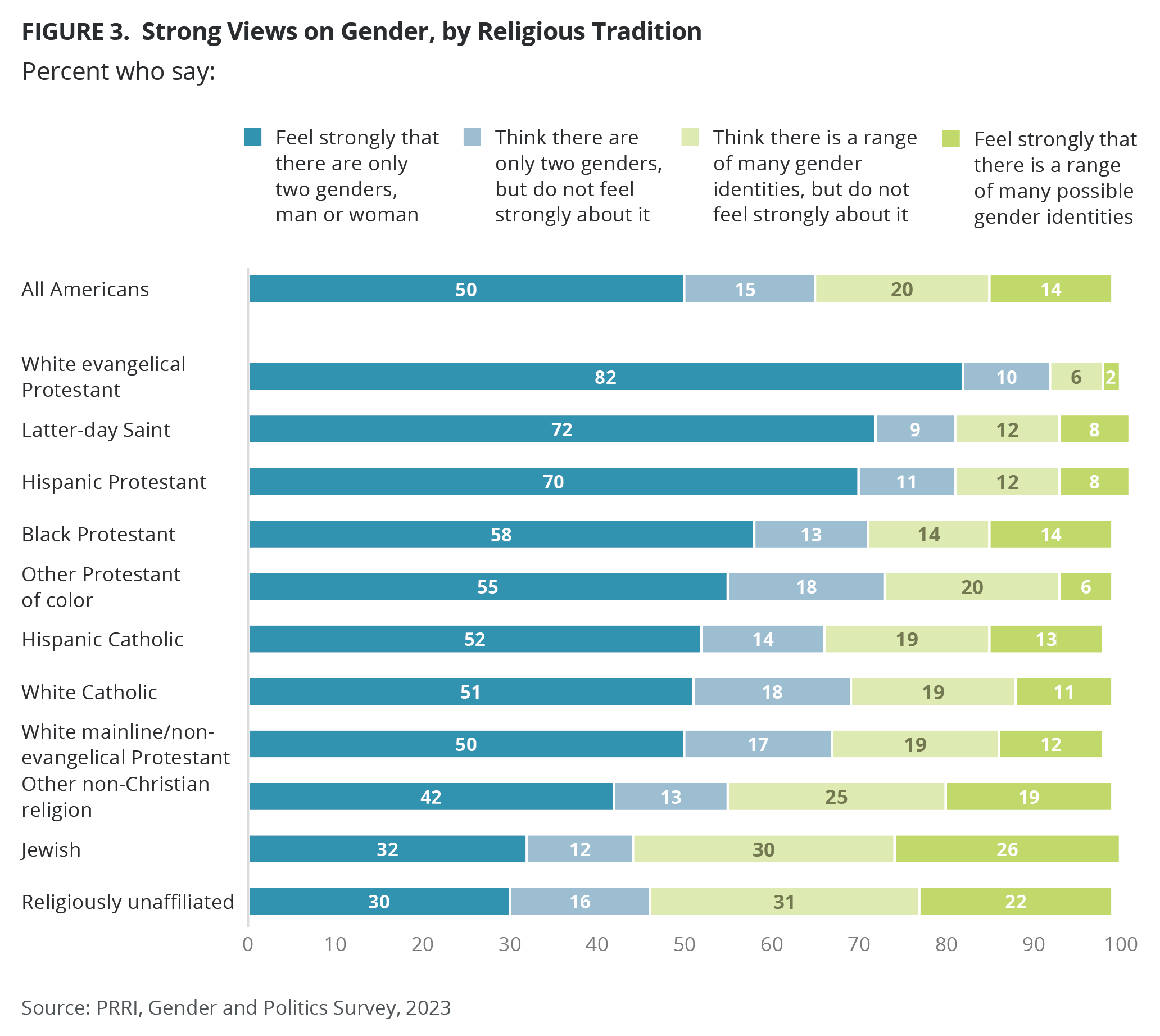
Nearly six in ten Americans with no college education (57%) strongly believe that there are only two genders, while nearly four in ten Americans with at least a college degree (38%) say the same. Americans who most trust either conservative TV news (86%) or Fox News (84%) are more likely than Americans who either don’t watch TV news (52%) or who trust mainstream TV news (38%) to hold a strong belief in a gender binary.
Who Do You Know? Relationships with LGBTQ People
Most Americans know someone who is gay, lesbian, or bisexual, but significantly fewer know someone who is transgender or who uses gender-neutral pronouns. Americans are about as likely to know someone who is gay, lesbian, or bisexual as they are to know someone who is a different race or ethnicity, or a different religion.
Knowing Someone LGBTQ
Around half of Americans (51%) say they have a close personal relationship with someone who is gay, lesbian, or bisexual, including 7% who identify themselves as gay, lesbian, or bisexual, 19% who say a close friend is gay, lesbian, or bisexual, and 25% who say they have a family member who belongs to one of these groups. An additional 31% say they have a more distant acquaintance who is gay, lesbian, or bisexual, and around two in ten Americans (16%) say they do not know anyone who identifies with these groups.
Americans are much less likely to report having a close personal relationship with someone who is transgender. Around one in ten Americans (11%) say they know someone who is transgender, including 1% who say they are transgender, 5% who say a close friend is, and 5% who say a family member is. Another quarter of Americans (25%) say they have an acquaintance who is transgender, and more than six in ten Americans (63%) say they do not know anyone who is transgender.
Similarly, around one in ten Americans (13%) have a close relationship with someone who uses gender-neutral pronouns, including 1% who say they use them, 6% who say a close friend does, and 6% who say a family member does. A further 23% say an acquaintance uses gender-neutral pronouns, and 62% say they do not know anyone who does.
In comparison, Americans are more likely to have close personal relationships with someone of a different race or religion than with someone who is transgender. Six in ten Americans (59%) say they have a friend or family member of a different race or ethnicity, while 64% say they have a close friend or family member who belongs to a different religion.
Generational Knowledge
Some of the deepest divides with respect to knowing someone who is LGBTQ fall along generational lines. Nearly six in ten Gen Z adults (58%) have a close relationship with someone who is gay, lesbian, or bisexual or belong to one of these groups themselves, while 23% have a close relationship with someone who uses gender-neutral pronouns, and 15% with someone who is transgender. Millennials are about as likely as Gen Z adults to say they have a close relationship with someone gay, lesbian, or bisexual (56%) or someone who is transgender (14%), but somewhat less likely to be close to someone who uses gender-neutral pronouns (16%).
Compared with the two youngest generations, much smaller shares of Gen X, the baby boomers, and the Silent Generation report having close relationships with LGBTQ people. A slim majority of Gen X Americans (51%) say they are or have a close relationship with someone gay, lesbian, or bisexual, while 10% say the same of someone who is transgender, and 12% say they’re close to someone who uses gender-neutral pronouns. Just less than half of boomers say they have a close relationship with someone who is gay, lesbian, or bisexual (47%), while 8% have a close relationship with someone who is transgender, and 10% are close to someone who uses gender-neutral pronouns. Just four in ten members of the Silent Generation say they, a close friend, or a family member is gay, lesbian, or bisexual (40%), while 8% say the same of someone who is transgender, and 12% say someone close to them uses gender-neutral pronouns.
Partisanship
Surprisingly, there are only minor differences across the partisan spectrum in how likely people are to have close relationships with LGBTQ people. Democrats are somewhat more likely than Republicans and independents to have close relationships with LGBTQ people. However, smaller shares of all three groups say they are close to someone who is transgender or who uses gender-neutral pronouns.
Nearly six in ten Democrats (59%), compared with 53% of independents and 41% of Republicans, say that they, a close friend, or family member is gay, lesbian, or bisexual. Around one in ten Democrats (13%) and independents (11%), along with 6% of Republicans, say they have a close personal relationship with someone who is transgender. Roughly two in ten Democrats (17%), compared with 13% of independents and 8% of Republicans, have a close relationship with someone who uses gender-neutral pronouns.
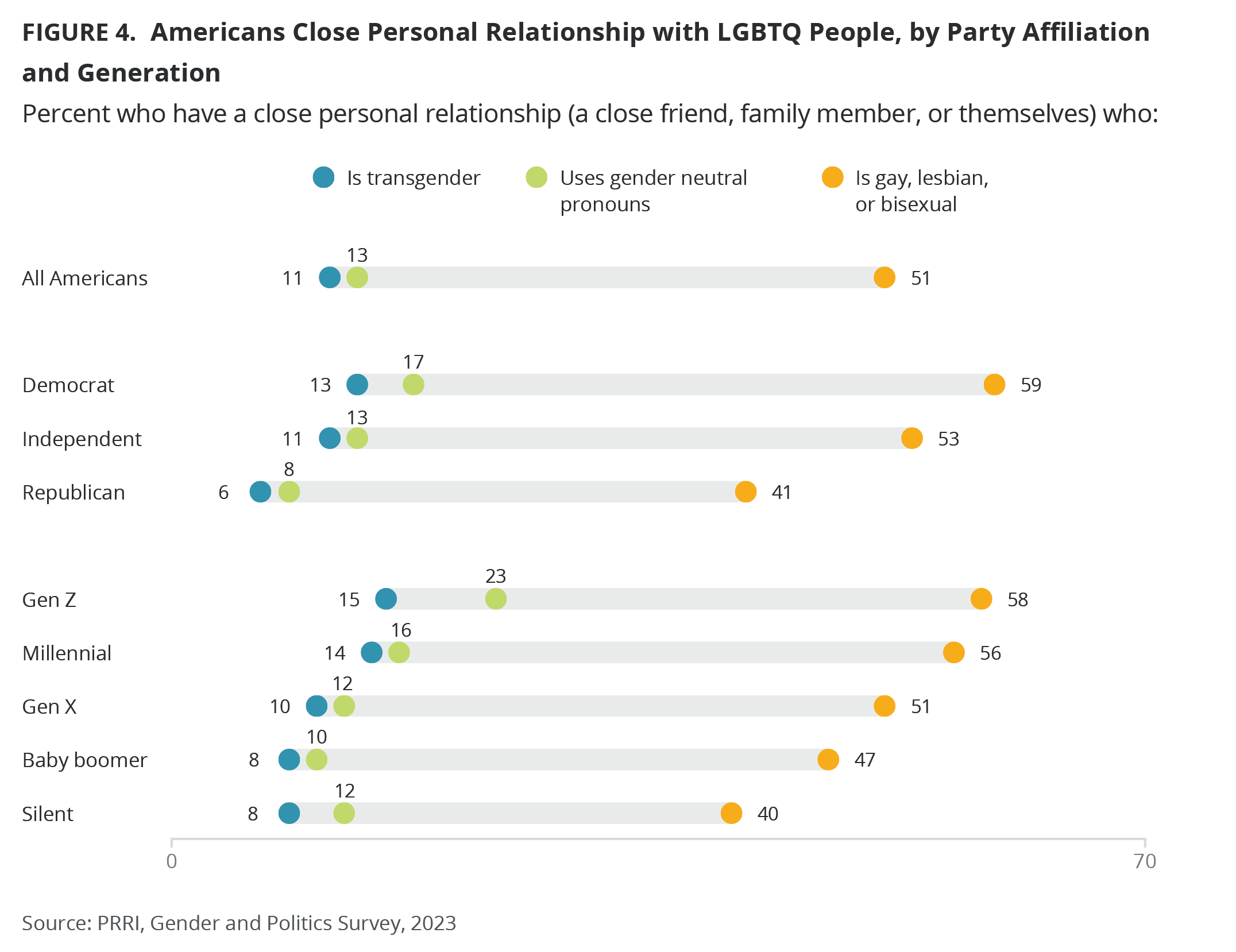
Levels of Comfort with LGBTQ Friends
Survey respondents were asked to rate how comfortable they would be if they found out that a friend was in a same-sex relationship, was transgender, or that they use gender-neutral pronouns or pronouns that may not match their perceived gender. Many Americans report that they would be comfortable with these situations, with roughly one in four saying that a person being LGBTQ or using different pronouns doesn’t make much difference in their relationship.
Comfort with Same-sex Relationships and Transgender People
About half of Americans (48%) report that they would be somewhat or very comfortable learning that a friend was in a same-sex relationship, while around a quarter (23%) say they would be uncomfortable, and roughly three in ten (28%) say it wouldn’t matter either way. Around four in ten Americans (41%) say they would be very or somewhat comfortable learning that a friend is transgender, while one-third (33%) say they would be uncomfortable. A quarter of Americans (25%) say it wouldn’t matter to them either way.
Generational divides run deep on this topic. Majorities of Gen Z adults and millennials say they would be comfortable learning that a friend is in a same-sex relationship (59% and 54%, respectively), compared with less than half of Gen Xers (46%), boomers (42%), and members of the Silent Generation (34%). Similarly, a slim majority of Gen Z adults (52%), and just under half of millennials (48%) say they would be comfortable learning that a friend is transgender, compared with smaller shares of Gen Xers (38%), boomers (36%), and members of the Silent Generation (26%). Around one in four members of each generation say that learning a friend is in a same-sex relationship or is transgender would not matter to them either way.
Gen Z women are one of the groups most likely to say they’d be comfortable with learning that a friend is in a same-sex relationship (65%) or transgender (58%). In comparison, a smaller share Gen Z men say the same (54% and 46%, respectively).
More than six in ten Democrats (63%) say they would be comfortable learning a friend is in a same-sex relationship, compared with half of independents (48%) and around one-third of Republicans (34%). Around one-fourth of Republicans (26%) and Democrats (24%), compared with 31% of independents, say learning that a friend is in a same-sex relationship would not matter to them either way. Similarly, a majority of Democrats (58%), compared with four in ten independents (43%) and two in ten Republicans (21%) say they would be comfortable learning that a friend is transgender. Around a quarter of independents (28%) and Democrats (24%), versus two in ten Republicans (19%), say it wouldn’t really matter to them if a friend were transgender.
Americans who most trust Fox News or right-wing media outlets are the least likely to report that they would feel comfortable learning that a friend is in a same-sex relationship (31% and 26%, respectively) or is transgender (22% and 21%, respectively). Americans who most trust mainstream news outlets are more likely to feel comfortable learning that a friend is in a same-sex relationship (56%) or transgender (49%).
White evangelical Protestants are notably less likely than other religious groups to report that they would be comfortable learning that a friend is in a same-sex relationship (29%) or is transgender (22%). Other white Christian groups are more likely to report they’d be comfortable finding out a friend is in a same-sex relationship or transgender, including white mainline/non-evangelical Protestants (53% and 44%, respectively), white Catholics (50% and 41%), and Latter-day Saints (40% and 31%). Around four in ten Black Protestants say they would be comfortable finding out that a friend is in a same-sex relationship (44%) or transgender (40%). Hispanic Protestants are less likely than Hispanic Catholics to say they’d be comfortable finding out a friend is in a same-sex relationship (32% vs. 43%), but the two groups do not differ significantly on finding out that a friend is transgender (30% vs. 39%). Jewish Americans are the group most likely to say they would be comfortable learning that a friend is in a same-sex relationship (69%) or transgender (65%), followed by religiously unaffiliated Americans (61% and 53%, respectively), and other non-Christian religious Americans (52% and 43%).
Americans who have a close personal relationship with someone who is transgender (a close friend, a family member, or they themselves are transgender) are generally comfortable with learning that a friend is transgender (62%). Americans who have an acquaintance who is transgender are similarly likely to say they would be comfortable learning a friend is transgender (57%). Around one-third of Americans who do not know anyone who is transgender (32%) say they would be comfortable learning that a friend is trans.
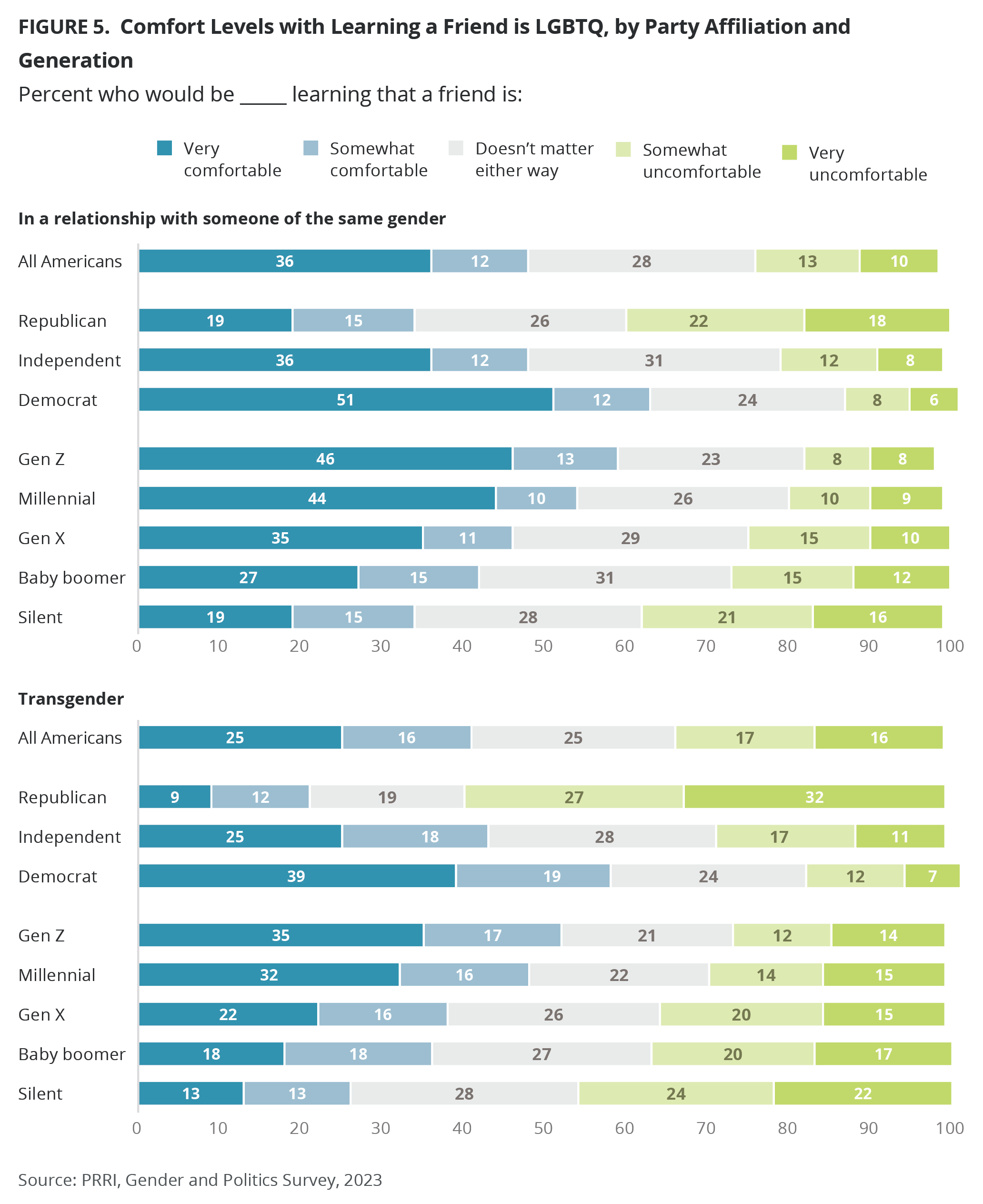
Pronoun Usage
Americans are divided in their reported level of comfort with finding out that a friend uses gender-neutral pronouns, such as “they,” instead of “he” or “she.” Around one-third of Americans (35%) say they would be somewhat or very comfortable if a friend told them they use gender-neutral pronouns, while 40% would be uncomfortable. One-quarter (23%) say it doesn’t matter either way.
Americans are similarly divided in their level of comfort with finding out that a friend told them that they use pronouns that do not match the respondent’s perception of the friend’s appearance. Around one-third of Americans (36%) say they would be somewhat or very comfortable, while 43% say they would be uncomfortable. Two in ten (21%) say it wouldn’t matter either way.
There are deep generational divides over pronoun use. Around half of Gen Z adults (48%) and four in ten millennials (42%), compared with fewer Gen Xers (31%), boomers (28%), and members of the Silent Generation (29%), say they would be comfortable with a friend using gender-neutral pronouns. Significant shares of Americans of all generations say that learning this about a friend wouldn’t really matter to them, including two in ten Gen Z adults (20%) and millennials (21%), and one-quarter of Gen Xers (24%), Boomers (26%), and members of the Silent Generation (27%). Comfort levels with learning that a friend uses pronouns that don’t match their own perception of their friend’s gender are roughly similar to comfort levels with gender-neutral pronouns within generational groups.
Gen Z women are much more likely than other women to say they would be comfortable learning that a friend uses gender-neutral pronouns (54%) or pronouns that might not match their perceived gender appearance (54%). Gen Z men are less likely to say the same (42% and 41%, respectively).
A majority of Democrats say they would be comfortable with learning that a friend uses gender-neutral pronouns (53%) or pronouns that might not match their own perception of their friend’s outward appearance (54%). Republicans are much less likely to say the same (17% and 18%, respectively). Independents fall in between (34% for both questions). Around one-quarter of Democrats (24%) and independents (27%), compared with 17% of Republicans, say that it wouldn’t matter to them either way if a friend used gender-neutral pronouns. Similar shares say the same of pronouns that might not match their friend’s perceived gender (21% of Democrats, 25% of independents, and 13% of Republicans).
White evangelical Protestants are less likely than nearly all other religious groups to say they would be comfortable with a friend telling them that they use gender-neutral pronouns (20%) or pronouns that might not match their perceived gender appearance (18%). Other white Christian groups are somewhat more likely to say they’d be comfortable with a friend using gender-neutral pronouns or pronouns that might not match their perceived gender, including white mainline/non-evangelical Protestants (35% and 36%, respectively), white Catholics (31% for both questions), and Latter-day Saints (25% and 24%). Around three in ten Hispanic Protestants express comfort with gender-neutral pronouns (26%) or pronouns that might not match a person’s perceived gender appearance (30%). Meanwhile, around a third of Hispanic Catholics say they are comfortable with both types of pronoun use (both 34%), as do similar shares of Black Protestants (both 35%) and other Protestants of color (36% and 35%).
Jewish Americans are the most likely to say they’d be comfortable learning that a friend uses gender-neutral pronouns (50%) or pronouns that might not match their perceived gender (55%). Around half of religiously unaffiliated Americans say the same (47% and 49%, respectively). Other non-Christian religious Americans are slightly less likely to say they would be comfortable in these situations (43% and 45%, respectively).
Americans who already have a close personal relationship with someone who uses gender-neutral pronouns (a close friend, family member, or they themselves) are most likely to say they’d be comfortable with a friend telling them that they use gender-neutral pronouns (57%) or pronouns that might not match their own perception of their friend’s gender appearance (56%). Those who have an acquaintance who uses gender-neutral pronouns are slightly less likely to be comfortable with a friend using these sorts of pronouns (51% for both). Americans who do not know anyone who uses gender-neutral pronouns are the least likely to say they’d be comfortable (26% for both).
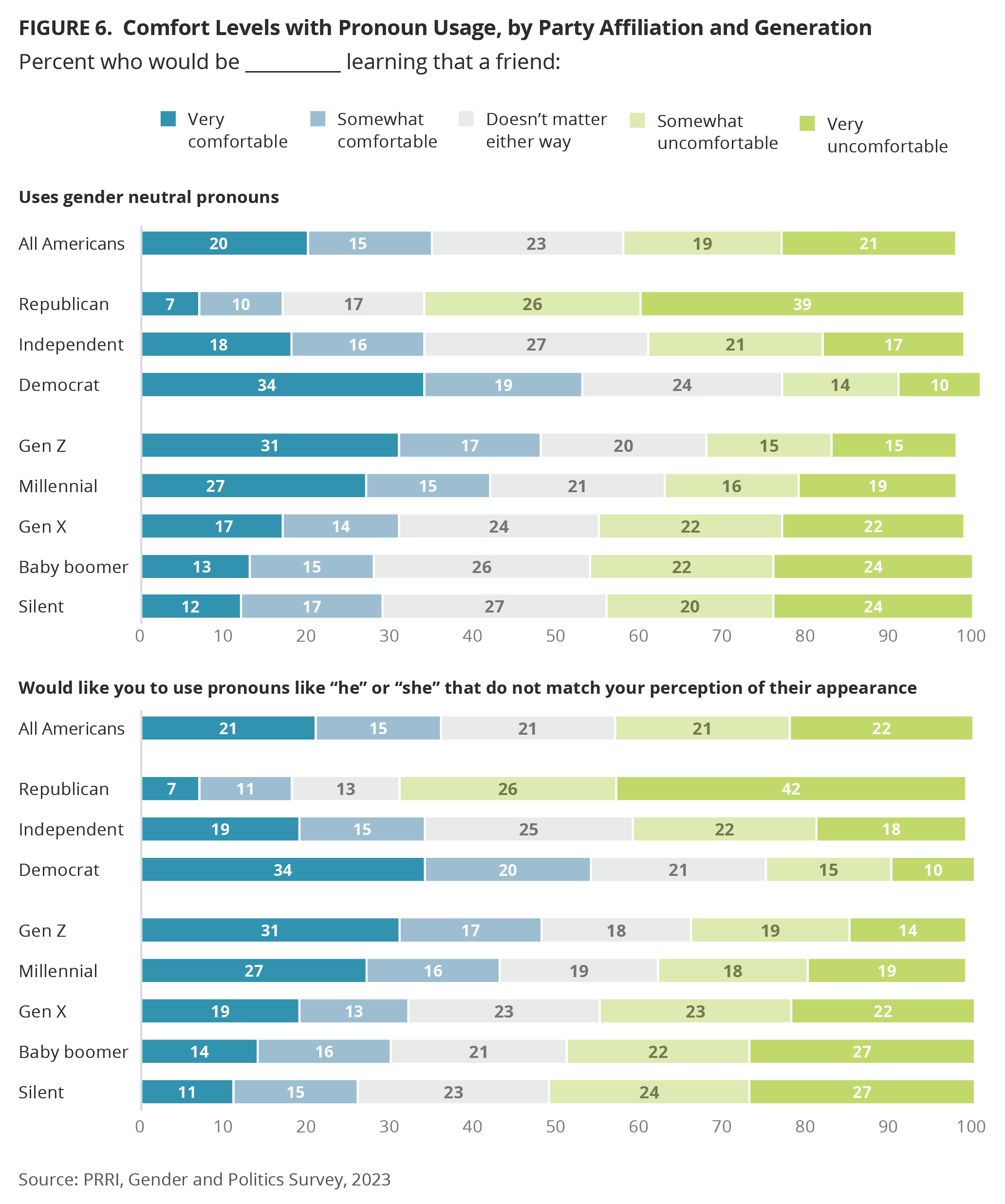
Social Issues and Public Education
Teaching About Same-Sex and Opposite-Sex Romantic Relationships in Public Schools
When Americans were asked at what point they think it is appropriate for public schools to discuss the idea that someone may seek out romantic relationships with a person of the same sex, 8% of Americans say it is appropriate beginning in early elementary school, 10% in later elementary school, 28% in middle school, and 19% in high school. Meanwhile, 34% say it is never appropriate to teach about same-sex romantic relationships in public schools. By contrast, there is slightly more support for teaching about opposite-sex romantic relationships: 9% say it is appropriate to teach starting in early elementary school, 13% in later elementary school, 33% in middle school, and 19% in high school. Just 24% think it is never appropriate to teach about opposite-sex romantic relationships in public schools.[4]
The majority of Republicans (55%) say it’s never appropriate to teach about same-sex romantic relationships in public schools, compared with 32% of independents and 18% of Democrats. By contrast, all partisan groups are less likely to oppose teaching about opposite-sex romantic relationships, including Republicans (37%), independents (23%), and Democrats (13%).
Opposition to teaching about same-sex romantic relationships varies among religious groups, with the majority of white evangelical Protestants (62%) saying this topic is never appropriate to teach in public schools. Around four in ten other Protestants of color (45%) and Black Protestants (41%); around one-third of white Catholics (33%), white mainline/non-evangelical Protestants (31%), and Hispanic Catholics (31%); 25% of members of non-Christian religions; and 19% of religiously unaffiliated Americans say teaching about same-sex romantic relationships is never appropriate in public schools. By contrast, religious groups are largely less likely to be in opposition to teaching about opposite-sex romantic relationship, with 41% of white evangelical Protestants, 32% of other Protestants of color, 27% of Black Protestants, 27% of Hispanic Catholics, 23% of white mainline Protestants/non-evangelical Protestants, 22% of white Catholics, 15% of members of non-Christian religions, and 13% of unaffiliated Americans saying it is never appropriate.[5]
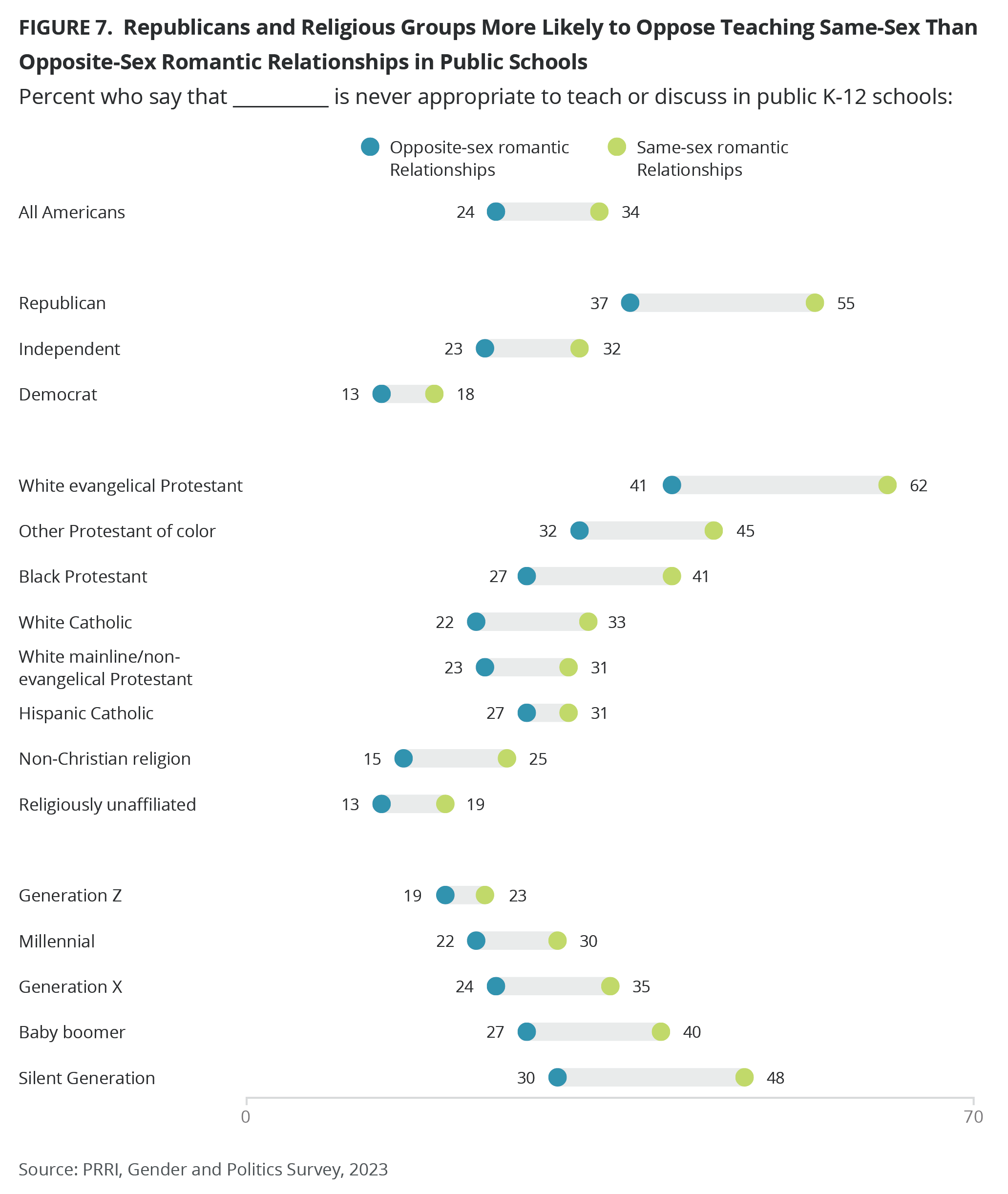
Members of Gen Z (23%) are notably less likely than millennials (30%), Gen Xers (35%), baby boomers (40%), and members of the Silent Generation (48%) to say it’s never appropriate to teach about same-sex relationships in public schools. Meanwhile, on the question of whether it is never appropriate to teach about opposite-sex relationships, Gen Zers (19%) do not differ too much from millennials (22%) and Gen Xers (24%) but do differ from baby boomers (27%) and members of the Silent Generation (30%).
Majorities of Americans who most trust conservative news outlets (61%) or Fox News (55%) say teaching about same-sex romantic relationships is never appropriate in public schools, compared with 36% of those who don’t watch any TV news and 25% who watch mainstream news. By contrast, members of all these groups are less likely to say it is never appropriate to teach about opposite-sex relationships, with smaller shares of those who most trust conservative news outlets (42%) or Fox News (39%), those who do not watch TV news (26%), and those who watch mainstream news (16%) saying this is the case.
Nearly four in ten Black Americans (38%) and members of other racial groups (38%), as well as about one-third of white Americans (35%) and Hispanic Americans (32%), and just 18% of Asian and Native Hawaiian/Pacific Islanders (AAPI) say it’s never appropriate to teach about same-sex romantic relationships in public schools. By contrast, 30% of Black Americans, 26% of Hispanic Americans, 23% of both white Americans and those belonging to other racial groups, and 18% of AAPI say it’s never appropriate to discuss opposite-sex romantic relationships in public schools.[6]
Opposition to discussing same-sex romantic relationships in public schools decreases with higher levels of education: 40% of Americans with a high school degree or less, 36% of Americans with some college, 23% of Americans with a college degree, and 27% of Americans with a postgraduate degree say it is never appropriate. The same pattern emerges regarding opposite-sex romantic relationships: 33% of Americans with a high school degree or less think it’s never appropriate to teach about these relationships in public schools, along with 22% of Americans with some college, 14% of Americans with a college degree, and 17% of Americans with a postgraduate degree. Whites without a college degree are notably more likely than whites with a college degree to say that same-sex romantic relationships (42% vs. 25%) and opposite-sex romantic relationships (28% vs. 15%) are never appropriate to discuss in public schools.
There are minimal differences between parents and nonparents on this issue. About one-third of both parents (37%) and nonparents (32%) say discussing same-sex romantic relationships is never appropriate in public schools, and 24% of both parents and nonparents who say it’s inappropriate to discuss opposite-sex romantic relationships.
A person is notably less likely to oppose teaching about same-sex relationships if they identify as lesbian, gay, or bisexual or are close to someone who does (27%) than if they only have a lesbian, gay, or bisexual acquaintance (36%) or do not know anyone who belongs to one of these groups (52%). Levels of opposition to teaching about same-sex relationships are also significantly lower among those who have a close relationship with someone who is transgender (21%) or who uses gender-neutral pronouns (19%) and those who have a transgender acquaintance (22%) or an acquaintance who uses gender-neutral pronouns (21%). Opposition is notably higher among those who don’t know anyone who is transgender (41%) or who uses gender-neutral pronouns (42%).
The percentage of Americans who think that teaching about opposite-sex romantic relationships in public schools is never appropriate is generally lower. Agreement that it is never appropriate is at about two in ten for Americans who have a close relationship with someone who is lesbian, gay, or bisexual (20%), or transgender (16%) or who uses gender neutral pronouns (15%). And the numbers are similar among those who have an acquaintance who identifies with one of those groups (24%, 15%, and 14%, respectively). Meanwhile, about three in ten Americans who don’t know anyone who identifies with one of these three groups say the same (36%, 29%, 29%, respectively).
Teaching About Gender Identity in Public Schools
When looking at views on teaching about gender identity in public schools, 7% of Americans think teaching that some people do not consider themselves to be a man or a woman is appropriate in early elementary school, 11% say in later elementary school, 26% say in middle school, and 18% say in high school, while 36% believe that it is never appropriate to teach this idea in public schools. Similarly, 8% of all Americans think it is appropriate to teach that some people are transgender , compared with 12% who say it is appropriate in later elementary school, 27% who say middle school, and 18% who say high school. However, 34% of Americans believe it is never appropriate to teach that some people are transgender.
Republicans are notably more likely to say that it is never appropriate to teach that some people do not consider themselves to be a man or a woman (60%) or that some people are transgender (58%) than independents (33% and 31%) and Democrats (17% and 16%).
White evangelical Protestants are the most likely to say it is never appropriate to teach that some people do not consider themselves to be a man or a woman (62%) or that some people are transgender (64%), followed by half of Latter-Day Saints (50% and 51%), less than half of Hispanic Protestants (48% and 45%), and about one-third of white mainline/non-evangelical Protestants (37% and 35%), white Catholics (37% and 34%), other Protestants of color (36% and 34%), Black Protestants (36% and 33%), and Hispanic Catholics (34% and 28%). Members of other non-Christian religions (24% and 26%), Jewish Americans (23% and 22%), and religiously unaffiliated Americans (21% and 20%) are the least likely to agree with these statements.
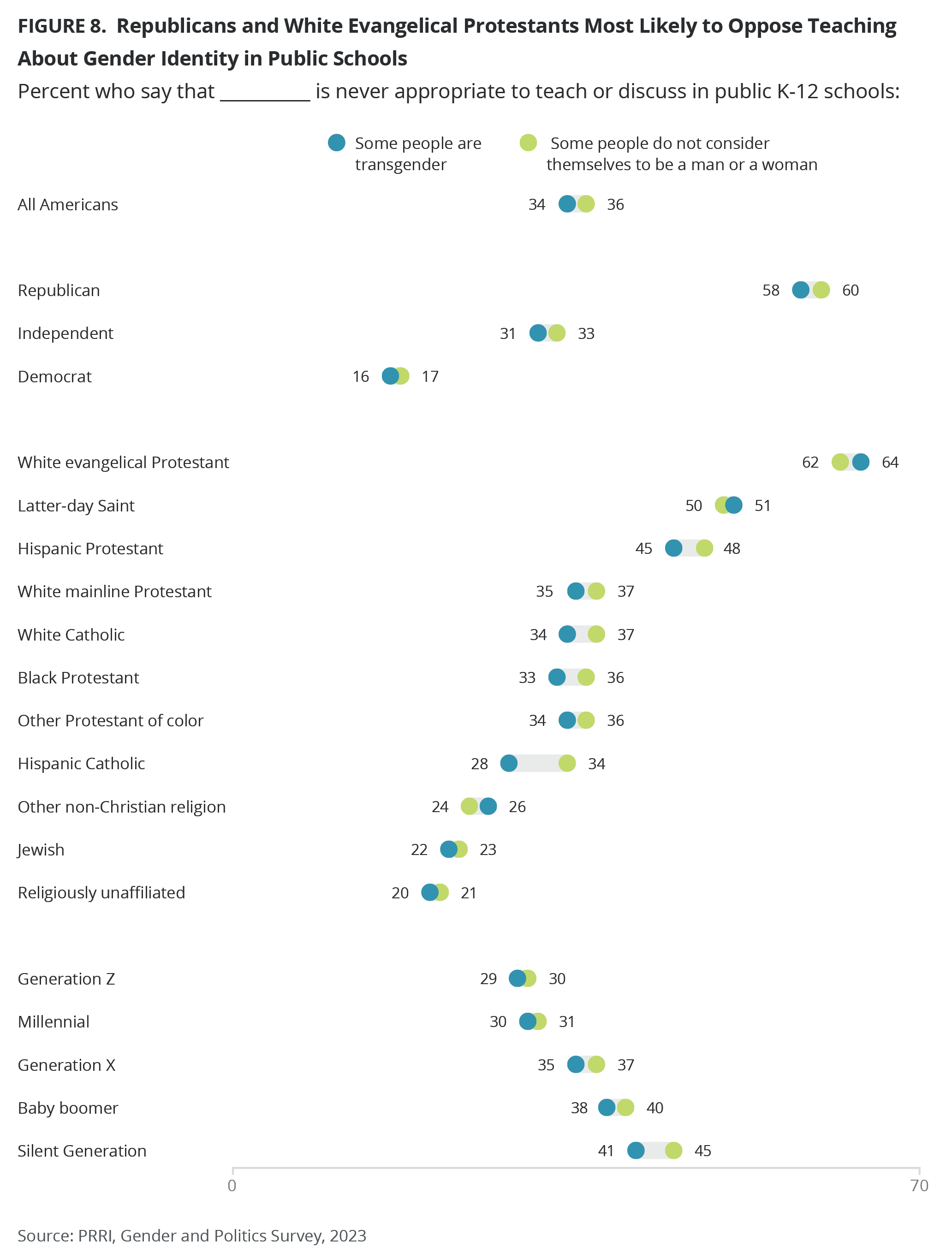
Opposition to teaching in public schools that some people do not consider themselves to be a man or a woman or that some people are transgender increases by generation: 30% and 29%, respectively, of Gen Zers agree with these statements, along with 31% and 30% of millennials, 37% and 35% of Gen Xers, 40% and 38% of baby boomers, and 45% and 41% of members of the Silent Generation.
The majority of Americans who most trust conservative news outlets (62% and 59%) or Fox News (59% and 56%) say teaching that some people do not consider themselves to be a man or a woman or that some people are transgender is never appropriate in public schools, compared with 39% and 37% of those who don’t watch any TV news and 25% and 23% of those who watch mainstream news.
White Americans (38% and 36%) do not differ significantly from Black Americans (34% and 32%), members of other racial groups (34% and 32%), and Hispanic Americans (34% and 30%) on these two questions. But AAPI (20% and 22%) are notably less likely to say it is never appropriate to teach these concepts in public schools.
Opposition to teaching that some people do not consider themselves to be a man or a woman or that some people are transgender in public schools decreases with education. Among Americans with a high school degree or less, 42% and 40% oppose these ideas, respectively, as do 38% and 35% of Americans with some college, 26% and 25% of college graduates, and 27% and 26% of postgraduates. However, whites with a college degree (45% and 43%) are significantly more likely than those without a college degree (both 27%) to oppose teaching gender identity in public schools.
Interestingly, there are minimal differences between parents and nonparents. More than one-third of both parents and nonparents say it is never appropriate to teach in public schools that some people do not consider themselves to be a man or a woman (38% parents vs. 35% nonparents) or that some people are transgender (36% vs. 33%).
If a person is lesbian, gay, or bisexual or close to someone who is, they are notably less likely to oppose teaching that some people do not consider themselves to be a man or a woman or that some people are transgender (29% and 27%, respectively) than someone who only has a lesbian, gay, or bisexual acquaintance (39% and 37%) or doesn’t know anyone who belongs to one of these groups (51% and 52%). Levels of opposition were significantly lower among those who identify as or are close to someone who is transgender (22% and 20%) or who uses gender-neutral pronouns (18% and 17%) as well as among those who have a transgender acquaintance (24% and 22%) or an acquaintance who uses gender-neutral pronouns (23% and 21%). Opposition is notably higher among those who don’t know anyone who is transgender (43% and 41%) or who uses gender-neutral pronouns (44% and 42%).
Teaching Sex Education in Public Schools
In general, Americans think it is appropriate for schools to provide comprehensive sex education that includes explanations of birth control, condoms, and other forms of contraception. Most Americans say that it is appropriate to start teaching this subject in middle school (53%) or in high school (28%), compared with 1% who say it is appropriate in early elementary school and 8% who say later in elementary school. Just 8% of Americans say this topic is never appropriate to teach in public schools. Fewer Americans say it is appropriate to teach sex education that emphasizes abstaining from sex except within marriage, with 39% saying it’s appropriate in middle school and 20% saying high school, compared with 2% who think it is appropriate in early elementary school and 7% who say later elementary school. Three in ten Americans (30%) say it is never appropriate to teach these ideas in public schools.
Nearly half of Republicans (46%), 53% of independents, and 61% of Democrats say it is appropriate to teach sex education that includes explanations of birth control, condoms, and other forms of contraception in middle school. About the same percentage of Republicans (45%), but notably fewer independents (39%) and Democrats (35%) say it is appropriate to teach sex education that emphasizes abstaining from sex except within marriage in middle school.
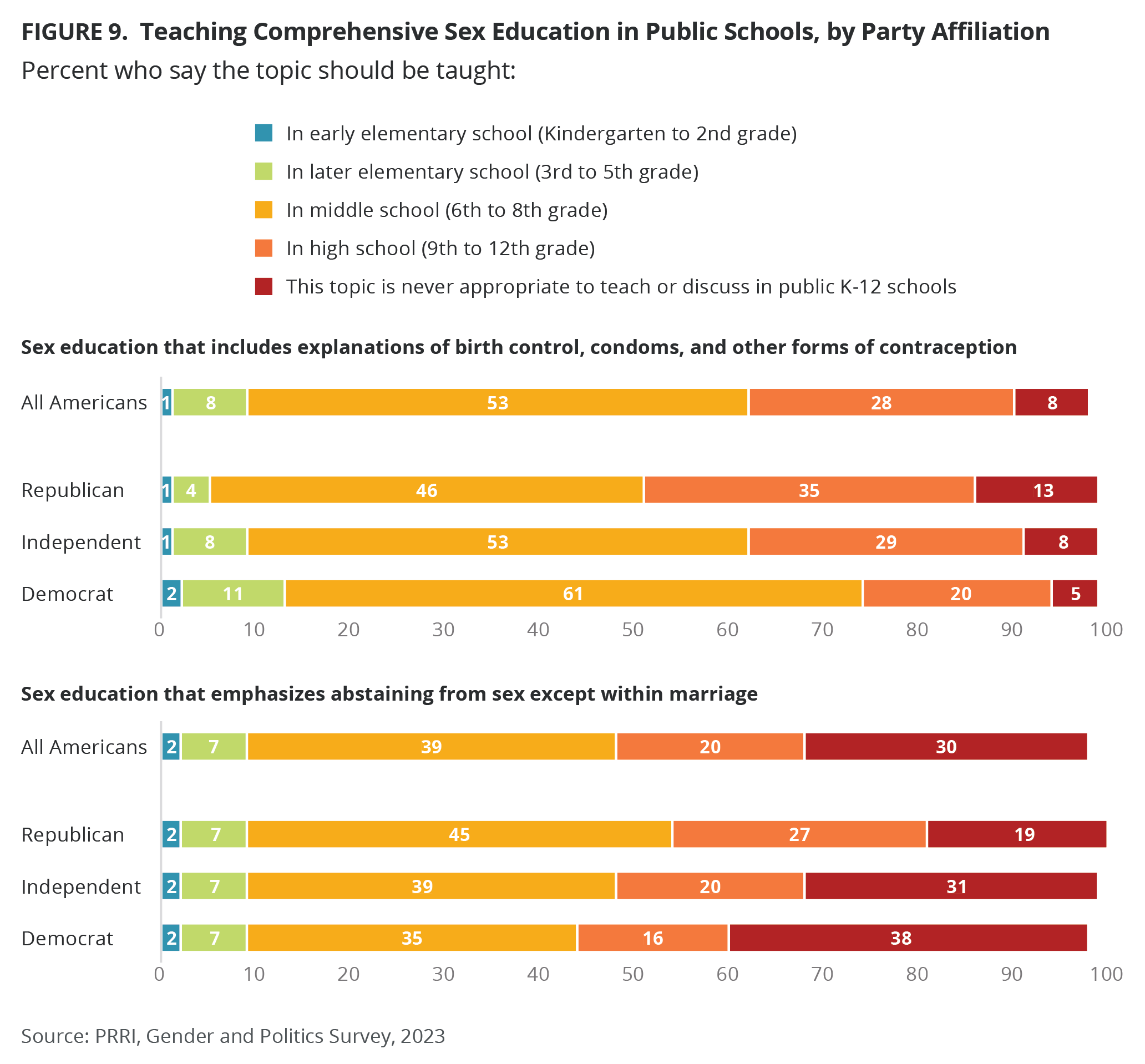
With the exception of white evangelical Protestants (42%), about half or more of the members of every religious group say it is appropriate to teach comprehensive sex education in middle school, including 46% of followers of other non-Christian religions, 47% of Latter-Day Saints, 48% of Hispanic Protestants, 49% of Hispanic Catholics, 51% of other Protestants of color, 53% of white Catholics, 56% of Black Protestants, 57% of white mainline/non-evangelical Protestants, and 61% of both religiously unaffiliated and Jewish Americans. . By contrast, less than half of other Protestants of color (47%) and white Christian groups, including white evangelical Protestants (47%), white Catholics (45%), white mainline/non-evangelical Protestants (44%), and Latter-Day Saints (43%), say it is appropriate to teach sex education that emphasizes abstaining from sex except within marriage in middle school, as do about four in ten Black Protestants (42%), Hispanic Catholics (39%), Hispanic Protestants (38%); about one-third of members of other non-Christian religions (35%) and religiously unaffiliated Americans (32%); and one-quarter of Jewish Americans (25%).
The majority of Americans who most trust mainstream news (58%) or do not watch TV news (54%) say it is appropriate to teach comprehensive sex education in middle school, compared with 36% of those who trust conservative news outlets the most and 41% of those who trust Fox News. By contrast, there is less variation on the question of whether it is appropriate to provide sex education that emphasizes abstaining from sex except within marriage, with 42% of those who trust Fox News the most, 41% of those who trust mainstream news, 40% of those who trust conservative media outlets, and 36% of those who don’t watch TV news saying it’s appropriate to teach this in middle school.
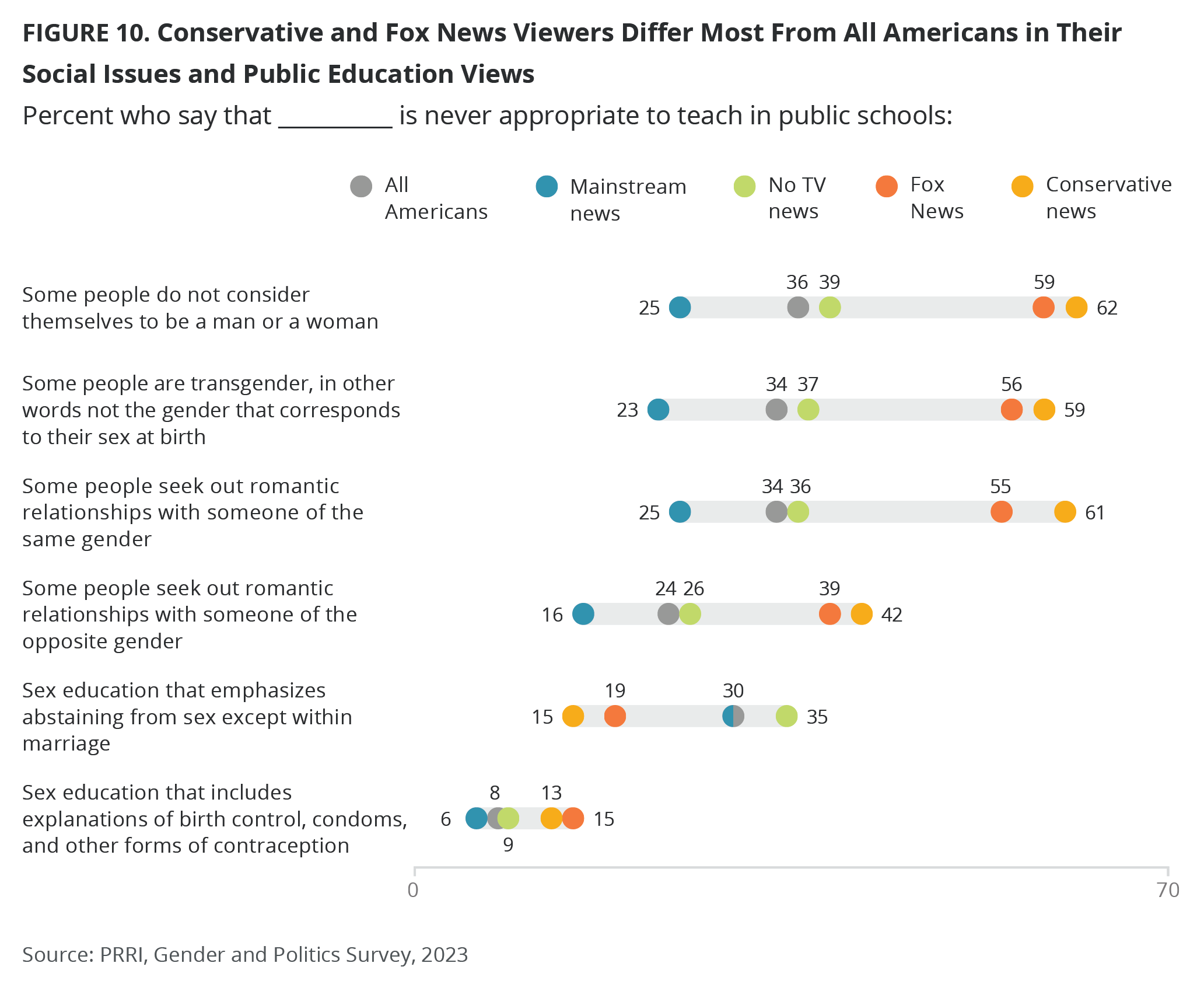
Public Schools’ Role
Public Schools Giving Students Harmful Information About Gender and Sexual Orientation
Americans are divided on whether public schools are giving students harmful information about gender and sexual orientation (49% say this is happening, and 50% say it’s not).[7] Republicans (80%) are notably more likely than independents (46%) and Democrats (25%) to agree with the idea that public schools are giving students harmful information about gender and sexual orientation.
White evangelical Protestants (78%) are the most likely to agree with idea that public schools are giving students harmful information, followed by Latter-day Saints (69%), other Protestants of color (64%), Hispanic Protestant (63%), white Catholics (54%), white mainline/non-evangelical Protestants (53%), Hispanic Catholics (45%), Black Protestants (44%), members of other non-Christian religions (40%), Jewish Americans (32%), and religiously unaffiliated Americans (30%).
Gen Z Americans (41%) and millennials (42%) are notably less likely than Gen Xers (53%), baby boomers (54%) and members of the Silent Generation (59%) to agree that public schools are giving students harmful information.
Americans who most trust conservative news outlets (84%) or Fox News (84%) are the most likely to agree that public schools are giving students harmful information, compared with about half of those who don’t watch any TV news (51%) and more than one-third of those who watch mainstream news (35%).
Americans with lower education levels are more likely to agree that public schools are giving students harmful information about gender and sexual orientation: 57% of those with a high school diploma or less education agree, as do 51% of those with some college education, 39% of those with a college degree, and 37% of those with a postgraduate degree. White Americans without a college degree are more likely than whites with a college degree to agree with this statement (59% vs. 39%).
Interestingly, there are no differences between parents and nonparents on this question. Among both parents and nonparents, 49% agree that public schools are giving students harmful information.
People who are lesbian, gay, or bisexual or are close to someone who is are notably less likely to agree with idea that public schools are giving students harmful information about gender and sexual orientation (41%) than those who only have a lesbian, gay, or bisexual acquaintance (56%) or do not know anyone who belongs to these groups (61%). Levels of agreement are slightly lower among those who are or have a friend or family member who is transgender (37%) or who uses gender-neutral pronouns (38%) and those who have an acquaintance who is transgender (39%) or who uses gender-neutral pronouns (36%). Agreement with the idea that public schools are giving students harmful information is notably higher among those who don’t know anybody who is transgender (55%) or who uses gender-neutral pronouns (56%).
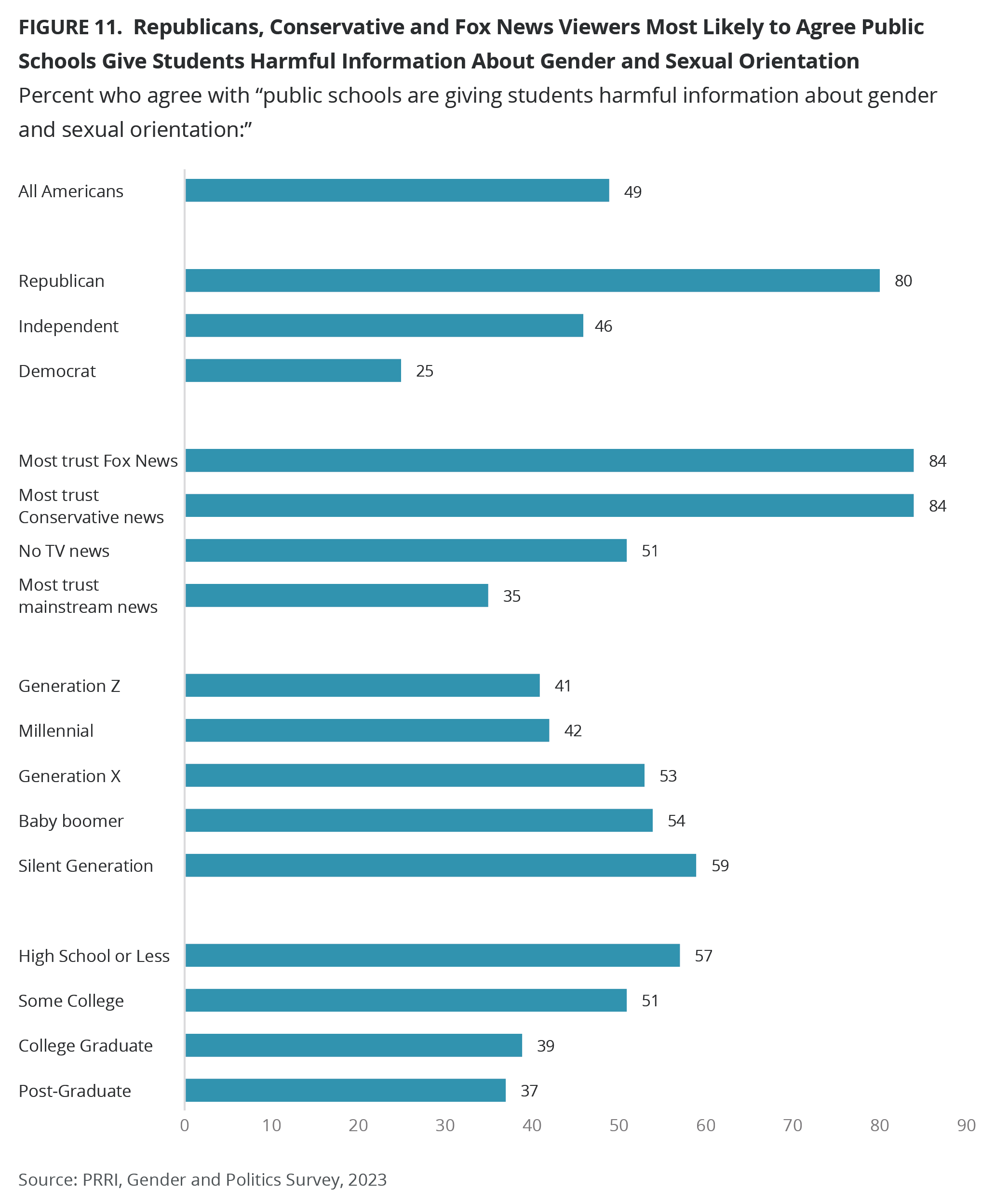
Public Schools Interfere Too Much With Parents’ Rights
Just over half of all Americans (53%) agree that public schools interfere too much with parents’ rights to determine what their children are taught, while 46% disagree. Nearly eight in ten Republicans (79%), half of independents (50%), and 31% of Democrats agree with this idea.
Although white evangelical Protestants (78%) are the religious group most likely to agree that public schools interfere too much with parents’ rights to determine what their children are taught, majorities of all Christian religious groups, including Latter-day Saints (70%), other Protestants of color (64%), Hispanic Protestants (60%), white Catholics (58%), Hispanic Catholics (55%), white mainline/non-evangelical Protestants (54%), and Black Protestants (54%), also agree. Non-Christians, including members of non-Christian religions (41%), Jewish Americans (40%), and religiously unaffiliated Americans (37%), were the least likely to agree with this idea.
Less than half of Gen Zers (42%) and millennials (48%) believe that public schools interfere with parents’ rights to choose what their children are taught, compared with 56% of Generation X, 58% of boomers, and 64% of the Silent Generation.
The vast majority of Americans who most trust conservative news outlets (88%) or Fox News (85%) agree that public schools interfere too much with parents’ rights to determine what their children are taught, compared with a slim majority of those who don’t watch any TV news (54%) and only four in ten of those who watch mainstream news (40%).
There are no differences in the rate of agreement among parents (52%) and nonparents (53%) on the question of whether public schools interfere too much with parents’ rights to determine what their children are taught.
Americans with lower education levels are more likely to agree that public schools interfere too much with parents’ rights than are those with more education: 62% of those with a high school diploma or less, 55% of those with some college education, 42% of those with a college degree, and 39% of those with a postgraduate degree agree with this idea. White Americans without are more likely than whites with a college degree to agree (63% vs. 41%).
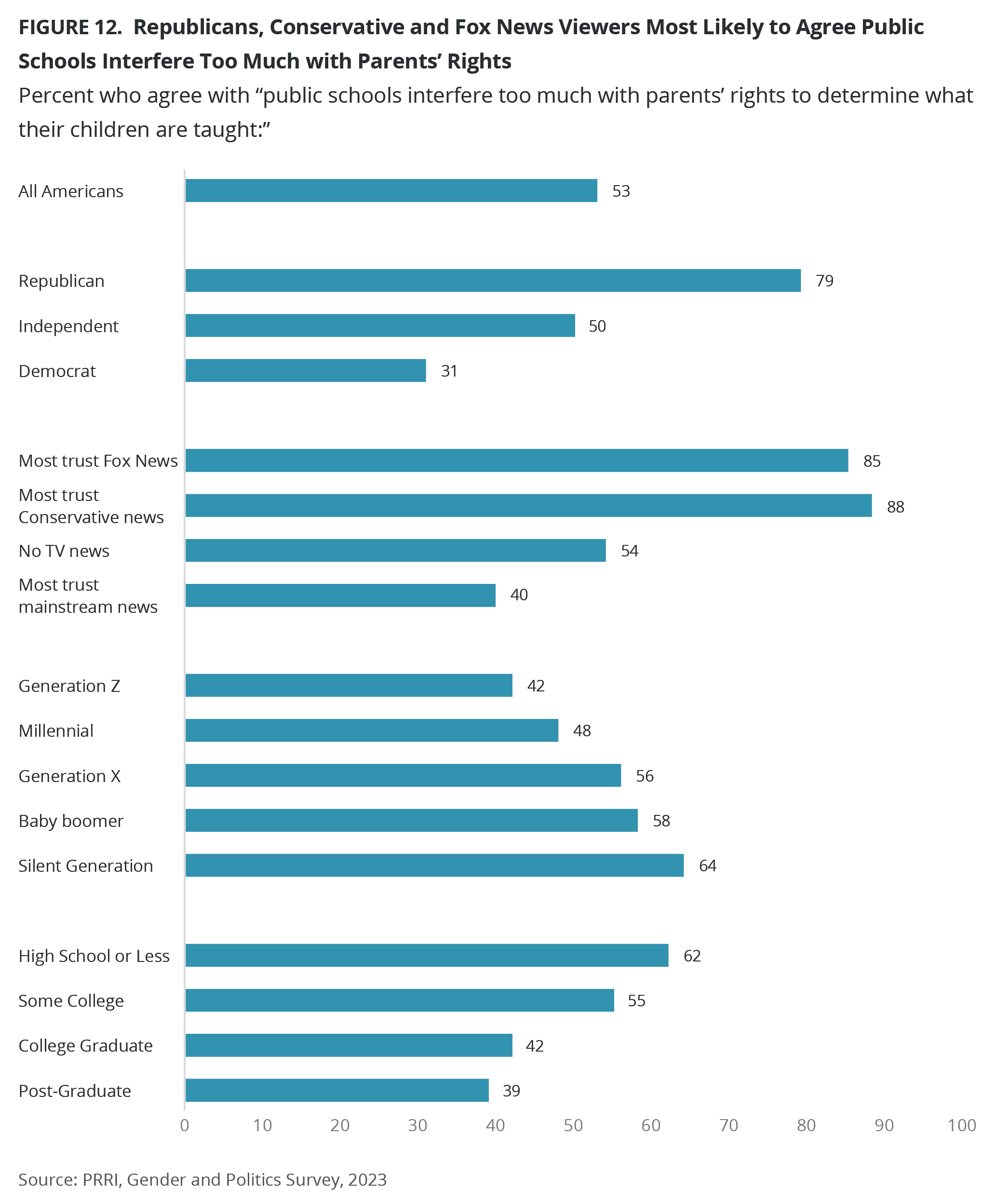
Descriptions of America Today
People Spend Too Much Time Talking About Gender and Pronouns
When asked whether they agree with various statements describing America today, more than six in ten Americans (62%) agree that people spend too much time talking about gender and pronouns, while just over one-third (37%) disagree. Republicans (86%) are significantly more likely than independents (63%) and Democrats (42%) to agree that people talk too much about gender and pronouns.
White evangelical Protestants are more likely than members of other religious groups to say that people spend too much time discussing gender and pronouns, with 85% in agreement.
Majorities from all other Christian groups also agree, including white Catholics and Latter-day Saints (both 71%), Hispanic Protestants (70%), white mainline/non-evangelical Protestants (67%), Black Protestants (62%), other Protestants of color (60%), Hispanic Catholics (55%), and Jewish Americans (53%). Members of other non-Christian religions and the religiously unaffiliated (both 47%) are the only groups that don’t reach majority agreement on this question.
Generation Z is the only generation in which less than half of the members agree that people spend too much time discussing gender and pronouns (48%), compared with 54% of millennials, 66% of Generation X, 70% of boomers, and 73% of the Silent Generation.
The vast majority of Americans who most trust conservative news outlets (85%) or Fox News (85%) say that people spend too much time discussing gender and pronouns, compared with 62% of those who don’t watch any TV news and 54% of those who watch mainstream news.
Again, there are no differences among parents (62%) and nonparents (63%) on this question.
People who are lesbian, gay, or bisexual, or are close to someone who is, are notably less likely to agree with idea that people spend too much time discussing gender and pronouns (56%), compared with those who only have an acquaintance who is lesbian, gay, or bisexual (69%), or who do not know anyone who belongs to one of these groups (69%). Levels of agreement are notably lower among those who identify as transgender or have someone close to them who does (47%), those who use gender-neutral pronouns or have a friend or family member who does (45%), and those who have a transgender acquaintance (52%) or an acquaintance who uses gender-neutral pronouns (51%). Agreement with the idea that people spend too much discussing gender and pronouns is much higher among those who don’t know anyone who is transgender (69%) or who uses gender-neutral pronouns (70%).
Young People Are Being Peer Pressured Into Being Transgender
More than four in ten Americans (43%) agree with the idea that “young people are being peer pressured into being transgender,” while 55% disagree. A majority of Republicans (74%) agree, compared with 41% of independents, and 21% of Democrats.
White evangelicals (75%), Latter-day Saints (70%), and Hispanic Protestants (60%) are the only religious groups in which majorities of adherents say that young people are being peer pressured into being transgender. By contrast, just under half of white mainline/non-evangelical Protestants (48%) and white Catholics (47%) believe this to be true, along with 42% of Black Protestants, 41% of other Protestants of color, 35% of Hispanic Catholics, and 32% of members of other non-Christian religious. Religiously unaffiliated Americans (27%) and Jewish Americans (25%) are the least likely to agree that young people are being peer pressured into being transgender.
Fewer than four in ten Generation Z Americans (36%) and millennials (38%) agree that young people are being peer pressured into becoming transgender, compared with about half of both Generation Xers (47%), boomers (48%), and members of the Silent Generation (47%).
The vast majority of Americans who most trust conservative news outlets (75%) or Fox News (76%) agree that young people are being peer pressured into becoming transgender, compared with 45% of those who don’t watch any TV news and 30% of those who watch mainstream news.
There are no differences among parents and nonparents on the question of whether young people are being pressured into being transgender (both 43%)
Agreement with this statement decreases with higher levels of education: 50% of those with a high school diploma or less, 45% of those with some college education, 36% of Americans with a bachelor’s degree, and 33% of Americans with a post graduate education agree that young people are being peer pressured into becoming transgender. There is a significant gap between white Americans without a college degree and white Americans with a college degree on this question (53% vs. 37%).
People who are lesbian, gay, or bisexual, or have a friend or family member who is, are notably less likely to agree with the idea that young people are being peer pressured into being transgender (35%), compared with those who only have an acquaintance who is lesbian, gay, or bisexual (51%) or who don’t know anyone belonging to these groups (55%). Levels of agreement are notably lower among those who are transgender or are close to someone who is (31%), those who use gender-neutral pronouns or have a family member or friend who does (30%), and those who have a transgender acquaintance (35%) or an acquaintance who uses gender-neutral pronouns (32%). Agreement with the idea that young people are being pressured into being transgender is notably higher among those who don’t know anyone who is transgender (49%) or who uses gender neutral-pronouns (50%).
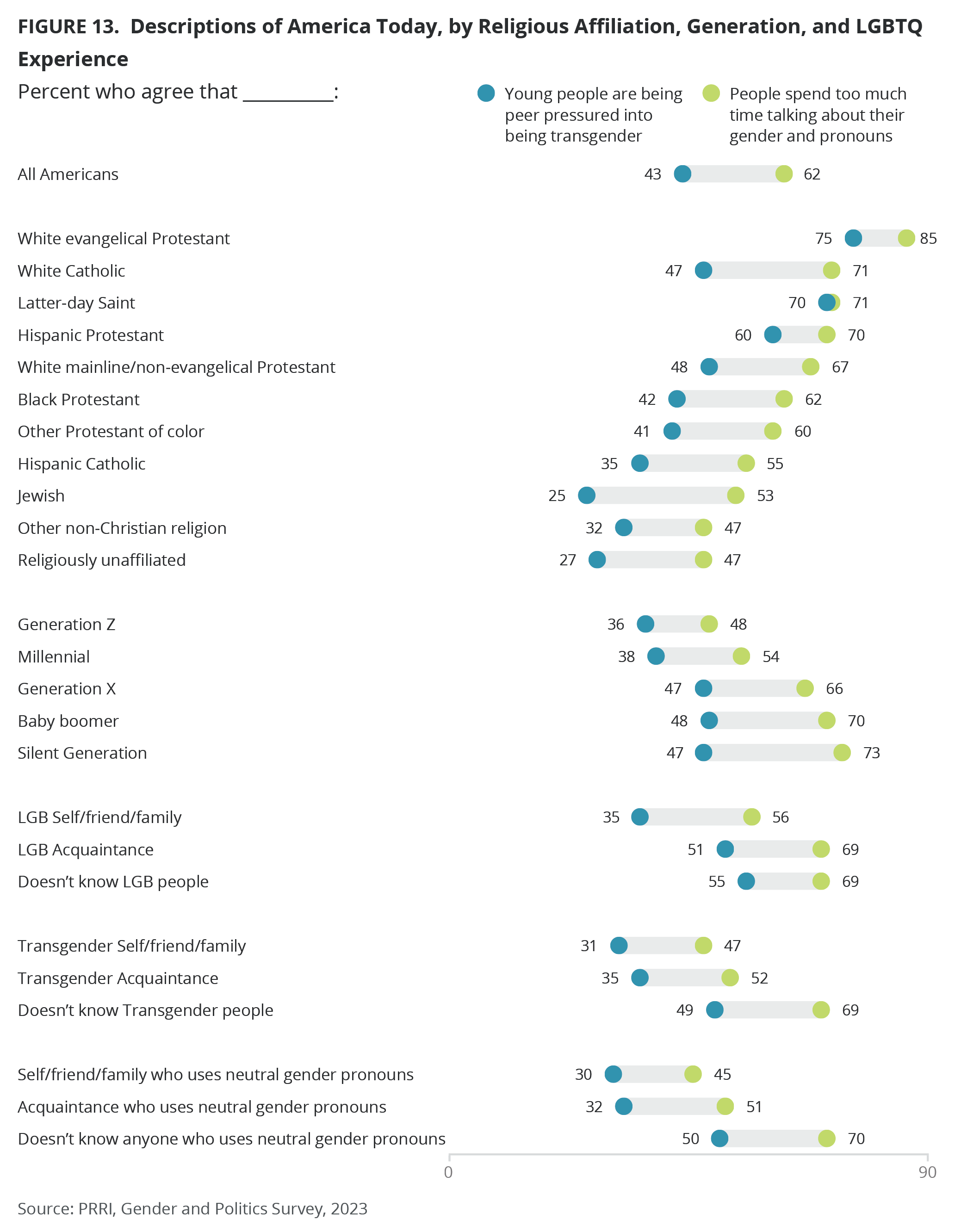
Survey Methodology
The survey was designed and conducted by PRRI. The survey was made possible through the generous support of the Arcus Foundation, the Gill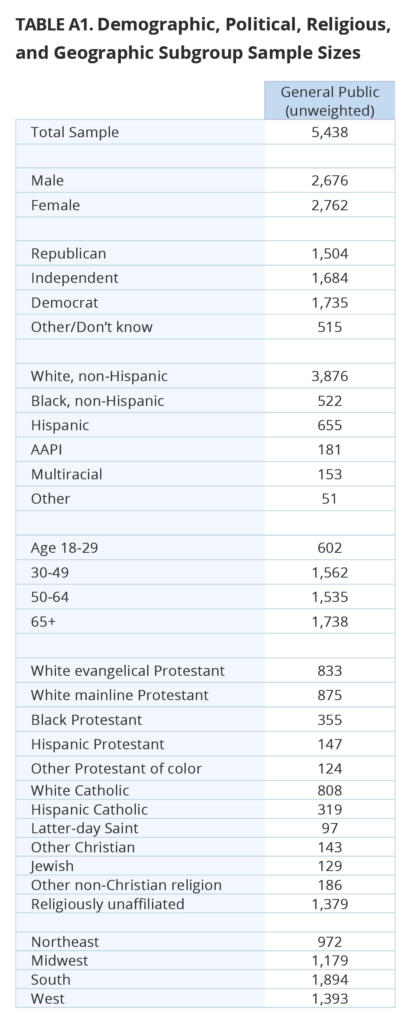 Foundation, and the E. Rhodes and Leona B. Carpenter Foundation. The survey was conducted among a representative sample of 5,046 adults (age 18 and up) living in all 50 states in the United States, who are part of Ipsos’ Knowledge Panel and an additional 392 who were recruited by Ipsos using opt-in survey panels to increase the sample sizes in smaller states. Interviews were conducted online between March 9 and 23, 2023.
Foundation, and the E. Rhodes and Leona B. Carpenter Foundation. The survey was conducted among a representative sample of 5,046 adults (age 18 and up) living in all 50 states in the United States, who are part of Ipsos’ Knowledge Panel and an additional 392 who were recruited by Ipsos using opt-in survey panels to increase the sample sizes in smaller states. Interviews were conducted online between March 9 and 23, 2023.
Respondents are recruited to the KnowledgePanel using an addressed-based sampling methodology from the Delivery Sequence File of the USPS – a database with full coverage of all delivery addresses in the U.S. As such, it covers all households regardless of their phone status, providing a representative online sample. Unlike opt-in panels, households are not permitted to “self-select” into the panel; and are generally limited to how many surveys they can take within a given time period.
The initial sample drawn from the KnowledgePanel was adjusted using pre-stratification weights so that it approximates the adult U.S. population defined by the latest March supplement of the Current Population Survey. Next, a probability proportional to size (PPS) sampling scheme was used to select a representative sample.
To reduce the effects of any non-response bias, a post-stratification adjustment was applied based on demographic distributions from the most recent American Community Survey (ACS). The post-stratification weight rebalanced the sample based on the following benchmarks: age, race and ethnicity, gender, Census division, metro area, education, and income. The sample weighting was accomplished using an iterative proportional fitting (IFP) process that simultaneously balances the distributions of all variables. Weights were trimmed to prevent individual interviews from having too much influence on the final results. In addition to an overall national weight, separate weights were computed for each state to ensure that the demographic characteristics of the sample closely approximate the demographic characteristics of the target populations. The state-level post-stratification weights rebalanced the sample based on the following benchmarks: age, race and ethnicity, gender, education, and income.
The margin of error for the national survey is +/- 1.5 percentage points at the 95% level of confidence, including the design effect for the survey of 1.3. In addition to sampling error, surveys may also be subject to error or bias due to question wording, context, and order effects. Additional details about the KnowledgePanel can be found on the Ipsos website: https://www.ipsos.com/en-us/solution/knowledgepanel
Endnotes
[1] The 2022 Survey did not have a large enough sample size to report most religious groups, so that year was excluded from this analysis.
[2] The generational breakdowns are as follows: the Silent Generation is 1925–1945, the baby boomers are 1946–1964, Generation X is 1965–1979, millennials are 1980–1994, and Generation Z is 1995–2012.
[3] In this survey, parents are identified as a current parent of children 18 years old or younger.
[4] Questions on same-sex romantic relationships asked: “Please tell us at what point do you think it’s appropriate for schools to discuss each of these issues, or if it’s never appropriate ‘That some men seek out romantic relationships with other men’ and ‘That some women seek out romantic relationships with other women.’” There are no meaningful differences in the responses to each question separately, with one exception: Americans are slightly more likely to say this topic is never appropriate to discuss in public schools when it relates to romantic relationships between men than when it relates to relationships between women (36% vs. 32%). Both questions were combined to compare differences in views on same-sex romantic relationships and opposite-sex romantic relationships.
[5] Because these questions were asked of half samples, we combine religious groups where sample sizes are too small to analyze individually. Other Protestants of color includes Hispanic, AAPI, American Indian or Alaskan Native, and multiracial Americans. Non-Christians include Jews, Muslims, Buddhists, Hindus, Unitarians, and members of other non-Christian religions.
[6] The sample sizes for AAPI are smaller for both questions (N=98, N=83, respectively). Results need to be interpreted with caution.
[7] PRRI did a question-wording test on this item, asking half of the sample about their views on public schools as described above and asking the other half the same question but adding the qualification “at too young an age.” There were no significant differences in responses: 48% agree with the first wording of the question, and 49% with the second, compared with about the same percentages who disagree (49% and 50%, respectively). Because responses were roughly the same for both formulations of the question, we combine both questions and report combined results here.


